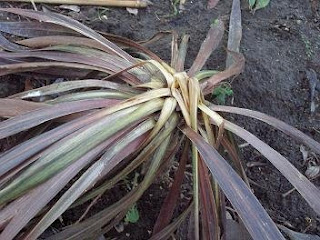A quick tour of my so-called jungle garden (i.e. the place I so optimistically planted up with climate change anticipation plants last summer) reveals I didn't exactly get out of the recent cold snap scot free.
 This is (or was) a purple cordyline. I was rather fond of it as it made a snazzy contrast with the libertias and hostas, to say nothing of a canna behind it, and gave me the pleasant illusion that I was quite good at putting plants together. I thought they were meant to be bone hardy, too.
This is (or was) a purple cordyline. I was rather fond of it as it made a snazzy contrast with the libertias and hostas, to say nothing of a canna behind it, and gave me the pleasant illusion that I was quite good at putting plants together. I thought they were meant to be bone hardy, too.
 The remains of a Melianthus major that was just getting into its stride last autumn...
The remains of a Melianthus major that was just getting into its stride last autumn...
...and my poor Astelia chathamica 'Silver Spear', lately of Chelsea 2008, which also looks to be less hardy than you would think.
Some of these might - just - come back, though I'm not sure they'll ever be quite the same again. Now, here's a quandary. do I press on and insist on a jungly area at the bottom of my garden anyway? (I'll have my banana-mad eight-year-old daughter to answer to if I don't). Do I resort to drought-tolerant Mediterranean plants only to have them washed away and drowned in a sea of mud every winter? Or do I plant a sea of English flowers and water them every five minutes all summer, also risking the customary deluge turning to a desert-like scorcher and the whole lot frazzling to a crisp as soon as I turn my back?
You know, this gardening lark isn't as straightforward as it looks.







3 comments:
It's always so sad when plants bite the dust. I have an astelia with finer leaves that is also in a most sorry state. I don't know the answer to your dilemma, but at least you have the perfect excuse for some horticultural retail therapy.
How disappointing for you!
It's extraodinary that some relatively hardy plants have succumbed to sustained frost whereas nominally tender ones - like my Pelargonium sidoides- are still bumping along looking reasonably happy.
Your cordyline will almost certainly come again from the roots - but do you really want a forest of little shoots, rather than one, big, architectural, shapely plant? (Rhetorical question, obviously.)
My Melianthus was hammered last year, when we had a particularly vicious frost one night, but last October it finally put up a little shoot from the roots. I've protected that with a mass of conifer clippings, and it seems reasonably alive, still. So don't lose heart.
About the 'sea of English flowers' - there are plenty that will do very well without needing lots of water, and without being hard, leathery Mediterranean jobs. Achilleas, some centaureas, Sanguisorbas, Geranium macrorrhizum, several lilies, particularly L. candidum, bearded irises, a number of the aster tribe, annual poppies, gaillardias, catananche - stuff like that. Would any of those suit?
I've since found out that there's been a mass turning up of toes locally in the cordyline department - particularly purple cordylines for some reason (presumably because they're less hardy. of course, but I don't know why purple colouring should mean you don't put up with frost as well as your green cousins).
I'll watch with interest for those foresty shoots... sounds quite interesting, and potentially more so than the original - I've always had a bit of a love-hate thing with cordylines. I like them in arrangements with other plants, but dislike the general ... cabbageyness of them.
Thanks for all those wonderful suggestions, Nigel - a lot there to inspire, especially catananche which I'd forgotten about - I grew them a few years back and they were truly wonderful, and so easy. Right, off to draw up that plant list now!
Post a Comment